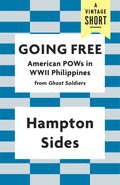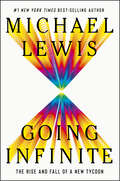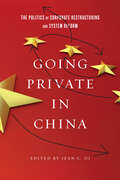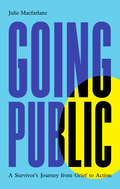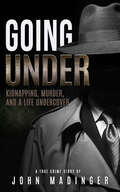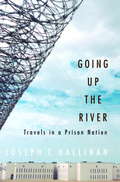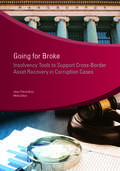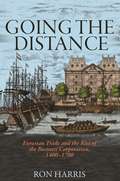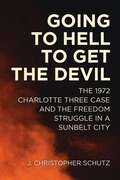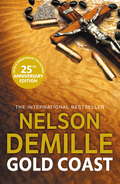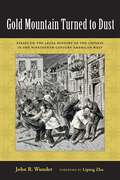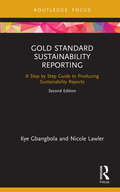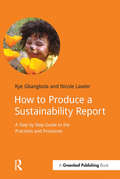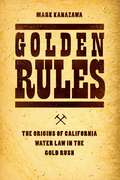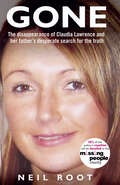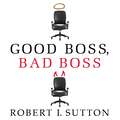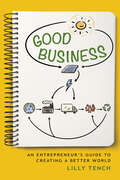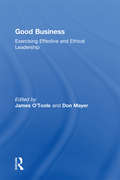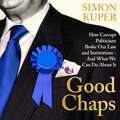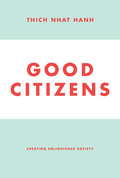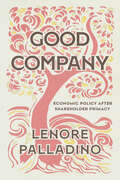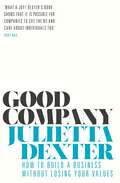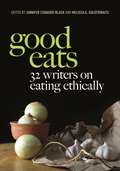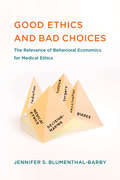- Table View
- List View
Going Free: American POWs in WWII Philippines (A Vintage Short)
by Hampton SidesAn eBook short.From Hampton Sides's Ghost Soldiers, a gripping narrative of World War II POWs on the brink of freedom. The men of Cabanatuan had been held by the Japanese since the Bataan Death March, in increasingly dire circumstances. With the war turning in the Americans' favor, the POWs worried that their captors would murder them all in the frenzy of an all-out withdrawal. Then one day in early January, 1945, the prison guards simply left. For a brief moment the haggard survivors of Cabanatuan were given the keys to their prison, though swift death was promised to anyone who dared leave. The prisoners waited nervously, all while (unbeknownst to them) a daring raid was being planned which would result in their rescue or their end. This is Hampton Sides at his most riveting, a fitting tribute to these soldiers who would be prisoners no more.
Going Infinite: The Rise And Fall Of A New Tycoon
by Michael LewisAN INSTANT #1 NEW YORK TIMES BESTSELLER One of the New Yorker's Best Books of 2023 • One of Pure Wow's 42 Book to Gift This Year • One of Fortune's Best Crypto Books of 2023 "Going Infinite is in many ways Lewis at his best. He marshals a complex global story without losing sight of the delightful and revealing human details. He is a world-class noticer."—Jesse Armstrong, writer and creator of HBO’s Succession, Times Literary Supplement "A stupefyingly pleasurable book to read." —Gideon Lewis-Kraus, The New Yorker "Going Infinite is an instant classic." — Helen Lewis, The Atlantic "Going Infinite is wildly entertaining, surprising multiple times on pretty much every page, but it adds up to a sad story, even a tragedy, for its central character and for all the people who lost so much thanks to his actions." —John Lanchester, London Review of Books "Will join Digital Gold as one of the all-time best crypto books."—Jeff John Roberts, Fortune "A wry, engaging writer and a gifted storyteller." —Julia M. Klein, Los Angeles Times "It may be easy to take for granted how entertainingly [Michael Lewis] pulls it off again in Going Infinite." —Brett Martin, GQ From the best-selling author of The Big Short and Flash Boys, the story of FTX’s spectacular collapse and the enigmatic founder at its center. When Michael Lewis first met him, Sam Bankman-Fried was the world’s youngest billionaire and crypto’s Gatsby. CEOs, celebrities, and leaders of small countries all vied for his time and cash after he catapulted, practically overnight, onto the Forbes billionaire list. Who was this rumpled guy in cargo shorts and limp white socks, whose eyes twitched across Zoom meetings as he played video games on the side? In Going Infinite Lewis sets out to answer this question, taking readers into the mind of Bankman-Fried, whose rise and fall offers an education in high-frequency trading, cryptocurrencies, philanthropy, bankruptcy, and the justice system. Both psychological portrait and financial roller-coaster ride, Going Infinite is Michael Lewis at the top of his game, tracing the mind-bending trajectory of a character who never liked the rules and was allowed to live by his own—until it all came undone.
Going Private in China: The Politics of Corporate Restructuring and System Reform
by Jean C. OiAs the Chinese Communist Party (CCP) set about reforming its centrally planned economy, it faced the thorny policy question of how to reform its state-owned enterprises (SOEs). Should it support a shift from public to private ownership of the means of production? Such a shift would challenge not only the CCP's socialist ideology but also its very legitimacy. Mixing the business of corporate restructuring with the politics of socialism presented nothing short of a policy nightmare. With policy-relevant acuity, the contributors to this wide-ranging volume address the questions about reform programs that have plagued China—and East Asia more broadly—since the 1990s. While China, Japan, and South Korea have all been criticized for implementing reform too slowly or too selectively, this volume delves into the broader contexts underlying certain institutional decisions. The book seeks to show that seemingly different political economies actually share surprising similarities, and problems. While Going Private in China sheds new light on China's corporate restructuring, it also offers new perspectives on how we think about the process of institutional change.
Going Public: A Survivor's Journey From Grief To Action
by Julie MacfarlaneGoing Public merges the worlds of personal and professional, activism and scholarship. Drawing upon decades of legal training, Macfarlane decodes the well-worn methods used by church, school, and state to silence survivors, from first reporting to cross-examination to non-disclosure agreements. At the same time, she lays bare the isolation and exhaustion of going public in her own life, as she takes her abuser to court, challenges her colleagues, and weathers a defamation lawsuit.
Going Under: Kidnapping, Murder, and a Life Undercover
by John Madinger&“I just want to make sure I&’ve got this right. You hanged all three of them? ...&” That&’s how it began, a case where the cops are crooks and the crooks are cops, a kidnapping where the victim is the bad guy, and the good guys must cross some lines to get him back. Welcome to the upside down and backward world of the undercover agent, where nothing is as it seems, and people – including the undercover – may not be what they appear.?GOING UNDER: Kidnapping, Murder, and A Life Undercover by former undercover agent John Madinger takes you into that world, and closer to the truth of the undercover experience than any other law enforcement memoir has ever gone. ""What is it like to work undercover?"" You&’re a sheepdog in wolf&’s clothing, running with the pack, and Madinger ran with the wolves for almost two decades. Now he shares his story to give you a unique look at American crime and the ""War on Drugs"" from the perspective of both cops and criminals. You&’ll go with the undercover cops to meetings with street-corner hustlers and rip-off artists and into the lives of the America&’s biggest rock stars, the world&’s richest man, an Academy Award-winning actor, the marijuana traffickers conspiring to assassinate a federal judge, and the President of the United States. It&’s an amazing ride, and there has never been another story like it.
Going Up the River: Travels in a Prison Nation
by Joseph T. HallinanThe American prison system has grown tenfold in thirty years, while crime rates have been relatively flat: 2 million people are behind bars on any given day, more prisoners than in any other country in the world -- half a million more than in Communist China, and the largest prison expansion the world has ever known. In Going Up The River, Joseph Hallinan gets to the heart of America's biggest growth industry, a self-perpetuating prison-industrial complex that has become entrenched without public awareness, much less voter consent. He answers, in an extraordinary way, the essential question: What, in human terms, is the price we pay? He has looked for answers to that question in every corner of the "prison nation," a world far off the media grid -- the America of struggling towns and cities left behind by the information age and desperate for jobs and money. Hallinan shows why the more prisons we build, the more prisoners we create, placating everyone at the expense of the voiceless prisoners, who together make up one of the largest migrations in our nation's history.
Going for Broke: Insolvency Tools to Support Cross-Border Asset Recovery in Corruption Cases (StAR Initiative)
by Jean-Pierre Brun Molly SilverGoing for Broke focuses on insolvency as an additional civil remedy in the arsenal of asset recovery practitioners, specifically in the context of grand corruption investigations and proceedings. The recovery of corruption proceeds is often sought through criminal prosecution and confiscation or civil lawsuits. Insolvency proceedings can also be an effective mechanism in the right circumstances, with their own advantages and disadvantages. The scenario that is most likely to benefit from this type of remedy is one in which bribes and stolen funds have been routed through special-purpose companies. This guidebook is intended as a practical tool to help policy makers, public officials, and those who have been entrusted with recovering their nations' stolen assets. It informs them about the ways that insolvency can be used to pursue proceeds of corruption. It may also serve as a quick reference for other practitioners: insolvency professionals, auditors, financial institutions, in-house counsel, and other professionals who deal with corruption.
Going the Distance: Eurasian Trade and the Rise of the Business Corporation, 1400-1700 (The Princeton Economic History of the Western World #88)
by Ron HarrisBefore the seventeenth century, trade across Eurasia was mostly conducted in short segments along the Silk Route and Indian Ocean. Business was organized in family firms, merchant networks, and state-owned enterprises, and dominated by Chinese, Indian, and Arabic traders. However, around 1600 the first two joint-stock corporations, the English and Dutch East India Companies, were established. Going the Distance tells the story of overland and maritime trade without Europeans, of European Cape Route trade without corporations, and of how new, large-scale, and impersonal organizations arose in Europe to control long-distance trade for more than three centuries.Ron Harris shows that by 1700, the scene and methods for global trade had dramatically changed: Dutch and English merchants shepherded goods directly from China and India to northwestern Europe. To understand this transformation, Harris compares the organizational forms used in four major regions: China, India, the Middle East, and Western Europe. The English and Dutch were the last to leap into Eurasian trade, and they innovated in order to compete. They raised capital from passive investors through impersonal stock markets and their joint-stock corporations deployed more capital, ships, and agents to deliver goods from their origins to consumers.Going the Distance explores the history behind a cornerstone of the modern economy, and how this organizational revolution contributed to the formation of global trade and the creation of the business corporation as a key factor in Europe’s economic rise.
Going to Hell to Get the Devil: The 1972 Charlotte Three Case and the Freedom Struggle in a Sunbelt City (Making the Modern South)
by J. Christopher SchutzThe 1968 burning of the Lazy B Stables in Charlotte, North Carolina, attracted little notice beyond coverage in local media. By the mid-1970s, however, the fire had become the center of a contentious and dubious arson case against a trio of Black civil rights activists, who became known as the “Charlotte Three.” The charges against the men garnered interest from federal law enforcement agents, investigative journalists— including one who later earned a Pulitzer Prize for coverage of the trials—numerous New Left and Black Power activists, and Amnesty International, which declared the defendants “political prisoners.” In Going to Hell to Get the Devil, J. Christopher Schutz offers the first comprehensive examination of this controversial case and its outcome. In the 1960s and 1970s, Charlotte’s leaders sought to portray their home as a placid, business-friendly, and racially moderate community. When New Left and Black Power activists threatened that stability, city leaders employed a variety of means to silence them, including the use of law enforcement against African Americans they deemed too zealous. In the Charlotte Three case, prosecutors paid prisoners for testimony against the Black activists on trial, resulting in their convictions with lengthy prison sentences. The unwanted publicity surrounding the case of the Charlotte Three became a critical pivot point in the Queen City’s post–World War II trajectory. Going to Hell to Get the Devil tells more than the story of an arson case; it also tells the story of the South’s future, as the fate of the Charlotte Three became emblematic of the decline of the African American freedom struggle and the causes it championed.
Gold Coast (John Sutter)
by Nelson DeMilleThe upmarket and salubrious area of Long Island is the stamping ground for a dying breed of America's super-rich. It is also the residence of John Sutter, lawyer - very top-drawer, old money, right clubs - and his sensual wife, Susan. Their lives are about to be turned dramatically upside down by their new 'next-door' neighbour - a certain Mr Frank Bellarosa, top Mafia don and master manipulator. It is he who will impress upon them a rule much older than the archaic etiquette of the old-money set: a favour accepted is a favour owed.Twenty-five years after it was first published, Nelson DeMille's Gold Coast stands as a modern thriller classic, a stylish, compelling and provocative novel will grip readers from beginning to end.
Gold Mountain Turned to Dust: Essays on the Legal History of the Chinese in the Nineteenth-Century American West
by John R. WunderSome half million Chinese immigrants settled in the American West in the nineteenth century. In spite of their vital contributions to the economy in gold mining, railroad construction, the founding of small businesses, and land reclamation, the Chinese were targets of systematic political discrimination and widespread violence. This legal history of the Chinese experience in the American West, based on the author&’s lifetime of research in legal sources all over the West—from California to Montana to New Mexico—serves as a basic account of the legal treatment of Chinese immigrants in the West.The first two essays deal with anti-Chinese racial violence and judicial discrimination. The remainder of the book examines legal precedents and judicial doctrines derived from Chinese cases in specific western states. The Chinese, Wunder shows, used the American legal system to protect their rights and test a variety of legal doctrines, making vital contributions to the legal history of the American West.
Gold Standard Sustainability Reporting: A Step by Step Guide to Producing Sustainability Reports
by Kye Gbangbola Nicole LawlerThis highly practical and concise book shows you how to undertake a reporting process and produce a sustainability report in line with the new standards and frameworks presented by the International Integrated Reporting Council (IIRC) and the Global Reporting Initiative (GRI). Fully updated to ensure compliance with the new standards, this second edition shows how to actually produce a sustainability report as well as the key processes in the planning: how to produce a business case; the development of actions plans; process and team leadership; and generating cross-functional buy-in. Templates are provided for certain steps in order to simplify the tasks involved at each point in the process. Anyone involved in delivering or developing a process to embed sustainability reporting for an organisation will find this book invaluable, for example, chief sustainability officers, chief financial officers and company secretaries. It will also be of interest to students in the field of sustainability.
Gold Standard Sustainability Reporting: A Step by Step Guide to Producing Sustainability Reports
by Kye Gbangbola Nicole LawlerThis how-to book provides a step-by-step guide to the constituent practices and processes needed to produce a sustainability report, structured around the Global Reporting Initiative’s Sustainability Reporting Process. It is written by the first GRI Certified training providers in the UK, who also produced the first GRI Certified Training course to be accredited by the Institute of Environmental Management & Assessment (IEMA). This book will show you: (1) how to produce a business case, develop action plans, secure leadership over process and people, and how to generate cross functional buy in, (2) how to do stakeholder engagement, materiality and assurance, and how to collect quality data and (3) how to plan and prepare to report, how to finalize and disseminate a report, and how to apply and manage the GRI Materiality Matters Check. The authors also provide invaluable tips on how to write a report, and how to position it on media platforms for both dissemination and feedback.In short, this book is a masterclass on precisely the things that individuals and organizations need and want to know to set up or improve the quality of their reporting processes, and to write effective reports.# This book will also enable stakeholders with a professional, personal or academic interest in reporting to learn how to evaluate a report – an essential skill for report writers too.
Golden Rules: The Origins of California Water Law in the Gold Rush
by Mark KanazawaFresh water has become scarce and will become even more so in the coming years, as continued population growth places ever greater demands on the supply of fresh water. At the same time, options for increasing that supply look to be ever more limited. No longer can we rely on technological solutions to meet growing demand. What we need is better management of the available water supply to ensure it goes further toward meeting basic human needs. But better management requires that we both understand the history underlying our current water regulation regime and think seriously about what changes to the law could be beneficial. For Golden Rules, Mark Kanazawa draws on previously untapped historical sources to trace the emergence of the current framework for resolving water-rights issues to California in the 1850s, when Gold Rush miners flooded the newly formed state. The need to circumscribe water use on private property in support of broader societal objectives brought to light a number of fundamental issues about how water rights ought to be defined and enforced through a system of laws. Many of these issues reverberate in today’s contentious debates about the relative merits of government and market regulation. By understanding how these laws developed across California’s mining camps and common-law courts, we can also gain a better sense of the challenges associated with adopting new property-rights regimes in the twenty-first century.
Gone in the Night: The Dowaliby Family's Encounter with Murder and the Law
by Rob Warden David PortessA true story of prosecutorial and judicial misconduct
Gone: The Disappearance of Claudia Lawrence and Her Father's Desperate Search for the Truth
by Neil RootThe last time that anyone heard from 35-year-old Claudia Lawrence, a chef at the University of York, was when she sent a text message to a friend on 18 March 2009 at 8.23 p.m. She has never been heard from or seen again, and her disappearance is a mystery that endures to this day.What happened to Claudia that early spring evening – or was it early the following morning on her way to work? There had been nothing abnormal about her behaviour before she vanished, and there were no signs of a struggle at her home. A Crimewatch reconstruction has been broadcast, and the police investigation into the case has cost more than £750,000. Dozens of interviews have thrown up numerous leads, but there are no concrete clues.With extensive access to her family and friends, in Gone, Neil Root assesses the facts and theories and asks: where is Claudia?
Good Boss, Bad Boss: How to Be the Best... and Learn from the Worst
by Robert SuttonFrom the New York Times bestselling author of The No Asshole Rule'I am frequently asked, "Tom, my brother/sister/friend is taking on a new leadership role. What should they read?" I always respond the same way, by recommending one and only one book: Bob Sutton's Good Boss, Bad Boss' - Tom Peters, New York Times bestselling author of In Search of Excellence.Good Boss, Bad Boss was inspired by the thousands of emails, calls and conversations that Robert Sutton received after publishing his bestseller The No Asshole Rule - he found that most of the stories and cries for help he received revolved around one central figure in every workplace: THE BOSS.Sutton's subsequent research showed that the success of every boss depended heavily on how well (or badly) they managed those they worked with and in Good Boss, Bad Boss he demonstrates this by weaving together the best psychological and management secrets with true stories, to reveal the mindset and moves of the best bosses, and contrasts them with the behaviour of the worst.If you want to understand how the best bosses think and act so that you can get better at your job or find a better boss to work for, Good Boss, Bad Boss has all the answers.
Good Business: An Entrepreneur's Guide to Creating a Better World
by Lilly TenchGood Business: An Entrepreneur's Guide to Creating a Better World is an illustrated guide that takes readers through the complicated but exhilarating landscape of social enterprise businesses that are changing the world.A social enterprise is a different kind of business, one that uses a market-driven approach to address a social or environmental problem such as poverty, environmental damage, or resource scarcity, with the dual goals of helping humanity and building a profitable business.With a climate crisis, a growing population, and diminishing natural resources, the need for socially-minded innovators is greater than ever. Good Business is designed to be a practical guide and tool for innovators, entrepreneurs, and dreamers who are attempting to navigate the complicated business models required for social enterprises.
Good Business: Exercising Effective and Ethical Leadership
by Don Mayer James O'TooleThis illuminating and practical collection of essays addresses the increasingly important topics of corporate ethics, social responsibility, and sustainability in the context of effective global business strategies. Instead of condemning business, or exhorting corporate leaders to "do good," the authors deal with the "hot button" issues of our time in a cool and rational manner, seeing them as opportunities rather than as problems. As the authors illustrate, there is no necessary trade-off between business leaders doing the right thing, on one hand, and the profitable thing, on the other. They demonstrate that ethics is not peripheral, or in addition to, the central concerns of business. To the contrary, ethics and good citizenship are at the heart of all good business strategies, decisions, and organizational cultures. These essays offer useful examples of how executives can create strategies and cultures that are, both and at the same time, ethical and effective--the essence of GOOD BUSINESS. A PUBLICATION OF THE INSTITUTE FOR ENTERPRISE ETHICS Daniels College of Business, University of Denver
Good Chaps: How Corrupt Politicians Broke Our Law and Institutions - And What We Can Do About It
by Simon KuperThe 'Good Chaps' theory holds that those who rise to power in the UK can be trusted to follow the rules and do the right thing. They're good chaps, after all. Yet Britain appears to have been taken over by bad chaps, and politics is awash with financial scandals, donors who have practically bought shares in political parties, and a shameless contempt for the rules.Simon Kuper, author of the Sunday Times Top Ten bestseller Chums, exposes how corruption took control of public life, and asks: how can we get politicians to behave like good chaps again?
Good Citizens: Creating Enlightened Society
by Thich Nhat HanhIn Good Citizens, Thich Nhat Hanh lays out the foundation for an international solidarity movement based on a shared sense of compassion, mindful consumption, and right action. Following these principles, he believes, is the path to world peace. <P> The book is based on our increased global interconnectedness and subsequent need for harmonious communication and a shared ethic to make our increasingly globalized world a more peaceful place. The book will be appreciated by people of all faiths and cultural backgrounds.While based on the basic Buddhist teachings of the Four Noble Truths and the Eight-Fold Path, Thich Nhat Hanh boldly leaves Buddhist terms behind as he offers his contribution to the creation of a truly global and nondenominational blueprint to overcoming deep-seated divisions and a vision of a world in harmony and the preservation of the planet. Key topics include the true root causes of discrimination; the exploration of the various forms of violence; economic, social, and sexual violence. He encourages the reader to practice nonviolence in all daily interactions, elaborates on the practice of generosity, and teaches the art of deep listening and loving speech to help reach a compromise and reestablish communication after misunderstandings have escalated into conflicts.Good Citizens also contains a new wording of the Five Mindfulness Trainings (traditionally called "precepts") for lay practitioners, bringing them in line with modern-day needs and realities. In their new form they are concrete and practical guidelines of ethical conduct that can be accepted by all traditions.Good Citizens also includes the complete text of the UN Manifesto 2000, a declaration of transforming violence and creating a culture of peace for the benefit of the children of the world. It was drafted by numerous Peace Nobel Prize recipients and signed by over 100 million people worldwide.Coinciding with a US presidential election year, Good Citizens reaches across all political backgrounds and faith traditions. It shows that dualistic thinking--Republican/Democrat, Christian/Muslim--creates tension and a false sense of separateness. When we realize that we share a common ethic and moral code, we can create a community that can change the world.
Good Company: Economic Policy after Shareholder Primacy
by Lenore PalladinoOn the faulty intellectual origins of shareholder primacy—and how policy can win back what’s been lost. In an era of shareholder primacy, share price is king. Businesses operate with short-term goals to deliver profits to shareholders, enjoying stability (and bonuses) in the process. While the public bemoans the doctrine for its insularity and wealth-consolidating effects, its influence over corporate governance persists. Good Company offers an exacting argument for why shareholder primacy was never the right model to follow for truly understanding how corporations operate. Lenore Palladino shows that corporations draw power from public charters—agreements that allow corporations to enjoy all manner of operational benefits. In return, companies are meant to innovate for the betterment of the societies that support them. However, that debt—increasingly wielded for stock buybacks and shareholder bonuses—is not being repaid. Palladino theorizes a modern corporation that plays its intended role while delivering social and economic good in the process and offers tangible policy solutions to make this a reality. Good Company is both an expert introduction to the political economy of the firm—as it was, as it is, as it can be—and a calibrating examination of how public policy can shape companies, and societies, for the better.
Good Company: How to Build a Business without Losing Your Values
by Julietta Dexter'What a joy! Inspiring and powerful.' -- Ruby WaxIn a highly competitive world, many think business success means being ruthless: maximising short-term return for shareholders, cutting overheads, crushing competition, and expanding at an exponential pace. Nothing says this more than Silicon Valley with its macho mantras like 'Move fast and break things' (Facebook) or 'We're a team not a family' (Netflix). But this model is looking increasingly flawed.What if there were another more compassionate way? Julietta Dexter believes there is. In this powerful and hopeful book, the award-winning CEO of The Communications Store explains how she built one of the world's most respected PR & communications companies without compromising her morals and without screwing over her staff or her clients. Highlighting a new paradigm for business, she explains why profit should be just one consideration among several, and why honesty, reliability and diversity are the best foundations for long-term success.
Good Eats: 32 Writers on Eating Ethically
by Melissa A. Goldthwaite Jennifer Cognard-BlackA collection of insightful and personal essays on the role of food in our livesIn an age of mass factory farming, processed and pre-packaged meals, and unprecedented food waste, how does one eat ethically?Featuring a highly diverse ensemble of award-winning writers, chefs, farmers, activists, educators, and journalists, Good Eats invites readers to think about what it means to eat according to individual and collective values. These essays are not lectures about what you should eat, nor an advertisement for the latest diet. Instead, the contributors tell stories of real people—real bellies, real bodies—including the writers themselves, who seek to understand the experiences, cultures, histories, and systems that have shaped their eating and their ethics.A wide array of themes, topics, and perspectives inform the selections within Good Eats, contributing to an enhanced understanding of how we eat as individuals and in groups. From factory farming and the exploitative labor practices surrounding chocolate production, to Indigenous foodways and home and community gardens, the topics featured in this collection describe the wider context of sustenance and ethical choices. Good Eats will encourage you to become more mindful of what and how you eat—and to consider the larger systems and cultures that shape that eating. These essays turn mundane meals into remarkable symbols of how we live, encouraging each of us to find food that is both sustaining and sustainable. Contributors include Ross Gay, DeLyssa Begay, Lynn Z. Bloom, Michael P. Branch, Nikky Finney, Shirley Geok-lin Lim, Barbara J. King, Aimee Nezhukumatathil, Leah Penniman, Adrienne Su, Ira Sukrungruang, Tina Vasquez, Nicole Walker, Thérèse Nelson, Lisa Knopp, Jane Brox, Maureen Stanton, Taté Walker, and many others.
Good Ethics and Bad Choices: The Relevance of Behavioral Economics for Medical Ethics (Basic Bioethics)
by Jennifer S. Blumenthal-BarbyAn analysis of how findings in behavioral economics challenge fundamental assumptions of medical ethics, integrating the latest research in both fields.Bioethicists have long argued for rational persuasion to help patients with medical decisions. But the findings of behavioral economics—popularized in Thaler and Sunstein&’s Nudge and other books—show that arguments depending on rational thinking are unlikely to be successful and even that the idea of purely rational persuasion may be a fiction. In Good Ethics and Bad Choices, Jennifer Blumenthal-Barby examines how behavioral economics challenges some of the most fundamental tenets of medical ethics. She not only integrates the latest research from both fields but also provides examples of how physicians apply concepts of behavioral economics in practice. Blumenthal-Barby analyzes ethical issues raised by &“nudging&” patient decision making and argues that the practice can improve patient decisions, prevent harm, and perhaps enhance autonomy. She then offers a more detailed ethical analysis of further questions that arise, including whether nudging amounts to manipulation, to what extent and at what point these techniques should be used, when and how their use would be wrong, and whether transparency about their use is required. She provides a snapshot of nudging &“in the weeds,&” reporting on practices she observed in clinical settings including psychiatry, pediatric critical care, and oncology. Warning that there is no &“single, simple account of the ethics of nudging,&” Blumenthal-Barby offers a qualified defense, arguing that a nudge can be justified in part by the extent to which it makes patients better off.
